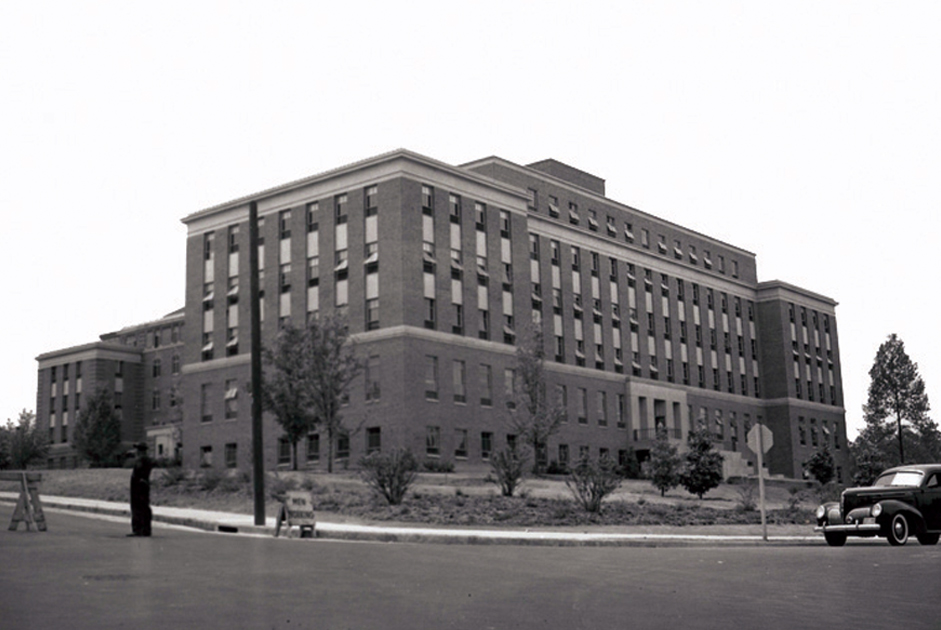In the late 1800s, most healthcare was taking place in the home. Only those who could not afford home-based healthcare went to the hospital. Hospitals of that time were places where the poor who suffered from serious illness could go for medical care. But as cities grew, a need for a different kind of hospital became evident.
In 1887, a group of women volunteers called the Ladies Twin City Hospital Association responded to that need by organizing to raise funds. The name “Twin City” refers to the two towns of Winston and Salem, two distinct cities until 1913 when they became the combined Winston-Salem. Within six months, in December 1887, this group of women used money saved from their household budgets to open the first Twin City Hospital inside the Martin Grogan home on North Liberty Street. At this new hospital, up to 10 patients could be hospitalized for $5 a week. The women (whose names included Reynolds, Hanes, and other prominent families) went on to bigger fundraising efforts by visiting homes and coordinating community meetings to raise money. They also asked the mayors of both Winston and of Salem to give $12 a month toward the effort.
Thanks to more fundraising led by the Ladies Twin City Hospital Association, a new, modern hospital was soon built from the ground up and opened debt-free in 1895 on Brookstown Avenue in downtown Winston.
In 1901, Twin-City Hospital on Brookstown started a nurse training program. By the time of its closing on November 4, 1914, the hospital had added a maternity ward and a children’s ward. Both the first hospital on Liberty Street and the second on Brookstown Avenue served indigent white people or poor newcomers. Slater Hospital was established for African Americans in 1902 and continued until 1912, after that, African Americans were admitted to Twin City Hospital.
As for the women who started it all, they did much more than just raise money to get these local hospitals started. Nurses and hospital leaders (then called matrons, superintendents, and directors of nursing) were almost all women for much of the hospitals’ early history. Of note, North Carolina became the first state to have registered nurses. And in the early days especially, it was a very difficult job.
Several smaller, more temporary hospitals tended to patients who were victims of epidemics that sometimes plagued the city. During the flu epidemics of 1918, 1919, and 1920, poor people who became ill were cared for at the A. Clint Miller home on Fifth Street, the J. W. Hanes home on Fourth Street, at the Depot Street School, and at a house on Maple Street owned by Charles H. Jones, a prominent African American businessman.
Twin-City hospital closed its doors in 1914 and transferred its patients to a brand-new, 90-bed hospital when it opened in the newly combined Winston-Salem. Originally known simply as the “New” Twin-City Hospital, it was renamed “City Memorial Hospital” in 1921 and by 1930 there were 547 beds.
The Reynolds’ family philanthropy also included health care for the marginalized. The Kate Bitting Reynolds Hospital for African Americans opened in 1938 with one hundred beds. In 1941, ninety more beds were added, and it became the third largest hospital for African Americans in the United States. The “Katie B.” provided care for thirty-two years until Reynolds Memorial/Reynolds Health Center replaced it in 1970.
As medical knowledge and treatment technologies continued to grow into the twentieth century, hospitals began to attract people of all economic levels. North Carolina Baptist Hospital, founded in 1923, and Forsyth Memorial Hospital, opened in 1964 as the successor to City Memorial, both provided high-tech medical care to residents of Winston-Salem and beyond.
Wake Forest School of Medicine (formerly Bowman Gray School of Medicine) was founded in 1902 as a two-year medical school on the campus of Wake Forest College in Wake Forest, NC. North Carolina Baptist Hospital had opened in 1923 as an 88-bed hospital in Winston-Salem. In 1941, the medical school expanded to four years and moved to Winston-Salem. Brenner Children’s Hospital and Health Services was established in 1986.
In 1997, CMI and Presbyterian Healthcare in Charlotte, North Carolina merged to form Novant Health, which currently includes 13 hospitals, six philanthropic foundations, a free-standing emergency department, physician clinics, outpatient surgery and diagnostic centers, rehabilitation programs and community health outreach programs in North Carolina, South Carolina, and Virginia, and the national MedQuest organization with 100 diagnostic imaging centers in 10 states.
In October 2020 Atrium Health acquired Wake Forest Baptist Health with Wake Forest School of Medicine becoming the academic Core of Atrium Health. This expanded the enterprise to a 42-hospital academic health system serving communities in four states: North Carolina, South Carolina, Georgia, and Virginia. Additionally ,in May 2022, healthcare giants Advocate Aurora Health and Atrium Health announced their merger. The new organization will now have roots in North Carolina, South Carolina, Georgia, Alabama, Wisconsin, and Illinois, serving over 5 million patients at over 1,000 sites of care.
“The world of healthcare as we know it is changing at warp speed – and it is rapidly becoming more digital, personalized, scientific and complex,” said Eugene A. Woods, president, and chief executive officer of Atrium Health.
As you can see, healthcare in Winston-Salem has grown by leaps and bounds in just 100 years.



















